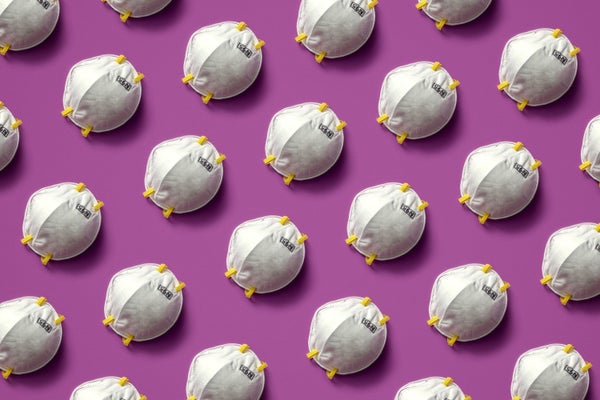This article was published in Scientific American’s former blog network and reflects the views of the author, not necessarily those of Scientific American
The items below are highlights from the newsletter, “Smart, useful, science stuff about COVID-19.” To receive newsletter issues daily in your inbox, sign-up here. Please consider a monthly contribution to support this newsletter.
Forecasts can be frustratingly speculative and inaccurate, but journalist Lydia Denworth's concise sketch of "how the COVID-19 pandemic could end" is worth your time. It quickly reviews what worked in three past pandemics and outbreaks—1918-1919 H1N1 influenza, SARS, and 2009 H1N1 influenza. The piece reports that the COVID-19 pandemic’s outcomes will depend on a 50/50 mix of socio-political factors and science (possible antiviral drugs and other treatments, screens/tests for antibodies and immunity, and a vaccine). In Scientific American, 4/28/20.
A 4/28/20 story by Jennifer Couzin-Frankel at Science explores the latest thinking about how to treat “happy hypoxics,” COVID-19 patients with extremely low levels of oxygen in their blood (a condition called hypoxia) who nonetheless experience no shortness of breath. It’s possible that the excess clotting seen in many COVID-19 patients could be causing the hypoxia, say doctors quoted in the story. If you are thinking of purchasing a pulse oximeter to detect your blood-oxygen saturation at home, read the last story’s last two paragraphs, which describe the lack of consensus among physicians about the value of this approach.
On supporting science journalism
If you're enjoying this article, consider supporting our award-winning journalism by subscribing. By purchasing a subscription you are helping to ensure the future of impactful stories about the discoveries and ideas shaping our world today.
Newsweek published a story on 4/27/20 by Fred Guterl, Naveed Jamali, and Tom O’Connor on the topic of how SARS-CoV-2 jumped from infecting animals to infecting humans. Yes, the virus originated in a wild animal population, and some researchers have ruled out a malicious release of a lab-created virus. But the new virus plausibly didn’t spread to humans from a market in China, the story states. Instead, the virus could have escaped accidentally (not been released intentionally) from a well-regarded infectious disease laboratory in Wuhan. This theory comes from a 3/27/20 U.S. Defense Intelligence Agency report, the magazine reports, but there is no evidence for the theory. Researchers at this lab do “gain-of-function” research—genetic engineering of new viruses to see if they could spread to humans. This type of research—funded in part by the U.S. Agency for International Development, so you know, us—is done in various countries these days as part of efforts to protect the public from virus strains that could evolve and cause outbreaks, not for weaponizing purposes, the story states.
Some weeks before more fingers pointed to the Wuhan infectious diseases lab, Scientific American published an excellent story, “How China’s ‘bat woman’ hunted down viruses from SARS to the new coronavirus,” about the lab’s director, Shi Zhengli. The story, by Beijing-based science journalist Jane Qiu, was updated 4/27/20 to “address rumors that SARS-CoV-2 emerged from Shi Zhengli's lab in China,” according to an editor’s note.
On the origins of the virus, Jane Qiu also recommends 4/29/20 coverage in The Economist, tweeting that their piece in goes into more depth on conspiracy theories. And the story is “in stark contrast to the depressingly bad reports on the topic that have turned some mainstream media into rumor mills,” she writes [registration required].
Andy Slavitt, former Medicare, Medicaid & Affordable Care Act head for President Obama, writes at Medium that widespread distribution of high-quality, medical-grade, reusable masks, such as the N-95 respirators used in hospitals, could defeat the new coronavirus outbreak, even in the absence of good treatments or an effective vaccine (4/25/20).
A state-by-state analysis by Harvard researchers and STAT reveals that most U.S. states are too far behind in daily testing for SARS-CoV-2 infections to be ready to “safely" relax lockdowns in the next week, reports Sharon Begley in a story for STAT (4/27/20). The good news is that 19 states, mostly in the U.S. South and West, reportedly are already doing enough daily testing, the analysis reportedly shows. Harder-hit states have to do more tests daily to get the data needed to determine when and how to safely re-open, the story states.
Some people in their 30s and 40s with COVID-19 are experiencing a type of strokes considered to be the deadliest (called large vessel occlusions), according to a 4/24/20 story by Ariana Eunjung Cha at The Washington Post. Some of the patients have no other chronic conditions or risk factors such as heart disease, diabetes or obesity, the story states.
In a 4/23/20 episode of Scientific American’s “Science Talk” podcast, Seattle-based science journalist W. Wayt Gibbs spoke with pathologists who are gaining insights from autopsies of people with COVID-19. The pathologists discuss what the disease does to the lungs and other tissues, whether patients actually had acute respiratory distress (ARDS) or not, and some surprising findings about what these patients actually die of. The full transcript is available too, so you have both audio and text-reading options.
For your visual entertainment, check out this tweet from @cromwell606 showing industrial pasta machines making the handy nuggets that many of us are more likely to dump into boiling water these days for quick meals during stay-at-home orders.
